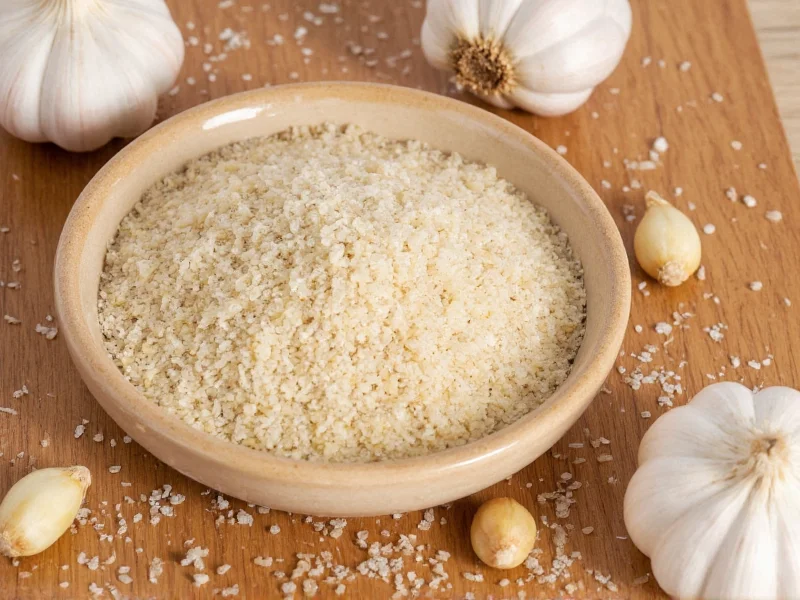When exploring the question is garlic salty, it's important to distinguish between fresh garlic and processed garlic products. Raw garlic has a complex flavor profile characterized by pungency, spiciness, and umami notes, but not saltiness. Understanding this difference is crucial for both culinary applications and dietary considerations.
Garlic's Natural Flavor Profile
Garlic's distinctive taste comes from sulfur compounds like allicin, which create its characteristic pungency when crushed or chopped. These compounds produce a sharp, spicy sensation rather than a salty one. The flavor evolves when cooked—becoming milder, sweeter, and more aromatic—but still doesn't develop saltiness unless actual salt is added.
Garlic vs. Garlic Salt: Critical Differences
Many people confuse fresh garlic with garlic salt, leading to the misconception that garlic itself is salty. This table clarifies the key differences:
| Product | Sodium Content | Primary Flavor | Composition |
|---|---|---|---|
| Fresh garlic clove | 1.5 mg per clove | Pungent, spicy | Water, carbohydrates, sulfur compounds |
| Garlic salt | Approx. 2,400 mg per teaspoon | Salty with garlic notes | 50% salt, 50% dried garlic |
| Garlic powder | 2-5 mg per teaspoon | Concentrated garlic | Dried, ground garlic |
Nutritional Facts: Sodium Content in Garlic
According to USDA nutritional data, a single raw garlic clove (about 3 grams) contains:
- Only 1.5 milligrams of sodium (less than 0.1% of daily value)
- Approximately 4.5 calories
- 0.2 grams of fiber
- Significant amounts of manganese, vitamin B6, and vitamin C
For comparison, the same weight of table salt contains about 1,100 milligrams of sodium. This dramatic difference explains why fresh garlic is not considered a salty food from a nutritional standpoint.
Why Some People Think Garlic Tastes Salty
Several factors contribute to the misconception that garlic is salty:
- Restaurant and processed foods: Many prepared foods containing garlic also contain significant salt, creating an association between the flavors
- Garlic salt confusion: People often use garlic salt instead of fresh garlic without realizing they're adding substantial sodium
- Flavor interaction: Garlic can enhance other flavors in food, including saltiness, making dishes seem saltier than they are
- Medical conditions: Certain health issues can alter taste perception, making some people perceive garlic as having salty notes
Culinary Implications: Using Garlic Without Adding Salt
Understanding that garlic does not contain sodium makes it an excellent ingredient for low-sodium diets. Chefs and home cooks can leverage garlic's flavor-enhancing properties to reduce actual salt usage while maintaining delicious taste profiles.
When developing recipes for sodium-conscious diets, consider these approaches:
- Use fresh garlic as a flavor base instead of salted products
- Roast whole garlic heads to develop natural sweetness without adding sodium
- Combine garlic with acid (lemon juice, vinegar) to enhance overall flavor perception
- When substituting garlic salt, use 1 clove fresh garlic or 1/8 teaspoon garlic powder plus the required salt
Health Considerations
For individuals monitoring sodium intake—such as those with hypertension or heart conditions—knowing that does garlic contain sodium in significant amounts is valuable information. Fresh garlic remains a heart-healthy ingredient that can actually support cardiovascular health through other mechanisms, unlike high-sodium seasonings.
However, those using garlic supplements should check labels carefully, as some formulations may contain added sodium or other ingredients that affect sodium content.
Common Misconceptions Clarified
Several persistent myths surround garlic and saltiness:
- Myth: Roasted garlic develops saltiness
Fact: Roasting brings out garlic's natural sugars, creating sweetness, not saltiness - Myth: Garlic powder is high in sodium
Fact: Pure garlic powder contains minimal sodium unless salt is added as an anti-caking agent - Myth: Garlic makes food taste salty
Fact: Garlic enhances existing flavors but doesn't create saltiness on its own
Practical Applications in Cooking
Professional chefs understand that is garlic considered a salty food is a common misunderstanding that affects cooking techniques. When developing dishes, they:
- Build flavor layers using garlic early in the cooking process
- Adjust salt levels separately after garlic has been incorporated
- Use garlic to reduce overall sodium while maintaining flavor complexity
- Recognize that different garlic varieties have varying pungency levels but none are salty
For home cooks wondering why does garlic taste salty sometimes, the answer typically lies in other ingredients or preparation methods rather than the garlic itself.
Is fresh garlic high in sodium?
No, fresh garlic is extremely low in sodium. A single garlic clove contains only about 1.5 milligrams of sodium, which is less than 0.1% of the recommended daily value. This negligible amount doesn't contribute to saltiness in food.
Why does garlic salt taste salty if garlic isn't salty?
Garlic salt is a mixture of approximately 50% salt and 50% dried garlic powder. The saltiness comes from the added sodium chloride, not from the garlic itself. This is why garlic salt contains about 2,400 milligrams of sodium per teaspoon while fresh garlic contains almost none.
Can I use garlic as a salt substitute?
While garlic isn't a direct salt substitute, it can enhance flavor perception, allowing you to reduce actual salt usage. Garlic works particularly well with acids like lemon juice or vinegar to create complex flavors without added sodium. For those monitoring sodium intake, fresh garlic is an excellent flavor booster that doesn't contribute meaningful sodium.
Does cooking garlic make it salty?
No, cooking garlic doesn't make it salty. The cooking process changes garlic's flavor compounds, making it sweeter and milder, but it doesn't increase sodium content. Any saltiness in cooked garlic dishes comes from added salt or salty ingredients, not from the garlic itself.
Is garlic powder high in sodium?
Pure garlic powder contains minimal sodium (about 2-5 mg per teaspoon), similar to fresh garlic. However, some commercial garlic powders may contain added salt or anti-caking agents with sodium. Always check the ingredient label if you're monitoring sodium intake.











 浙公网安备
33010002000092号
浙公网安备
33010002000092号 浙B2-20120091-4
浙B2-20120091-4